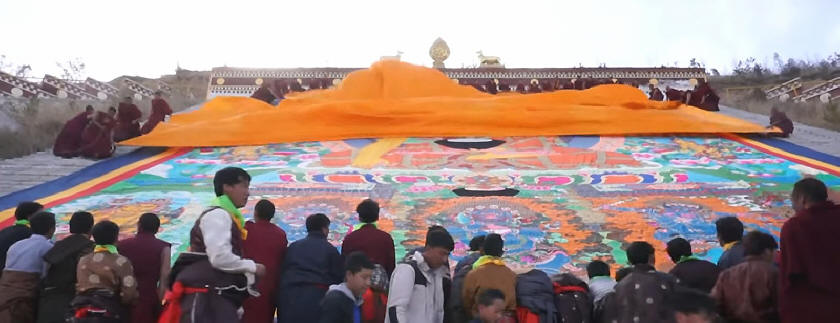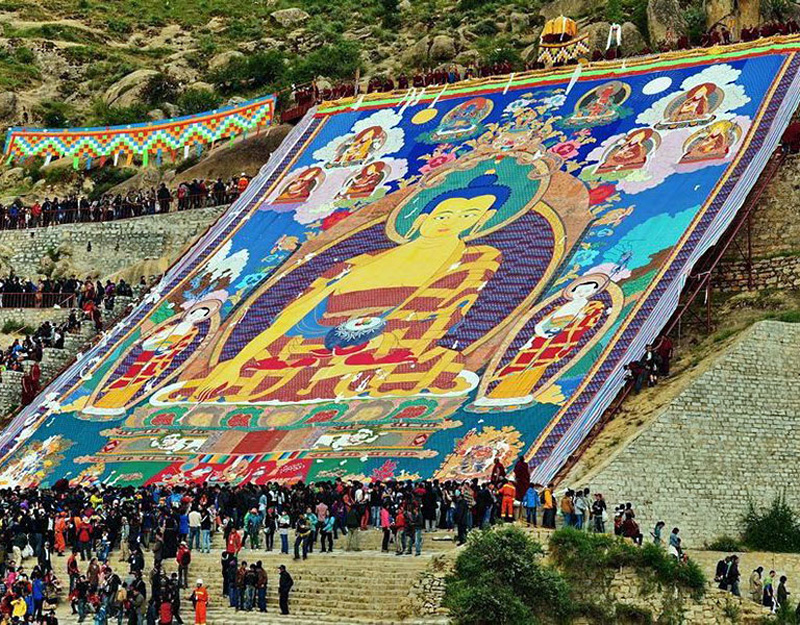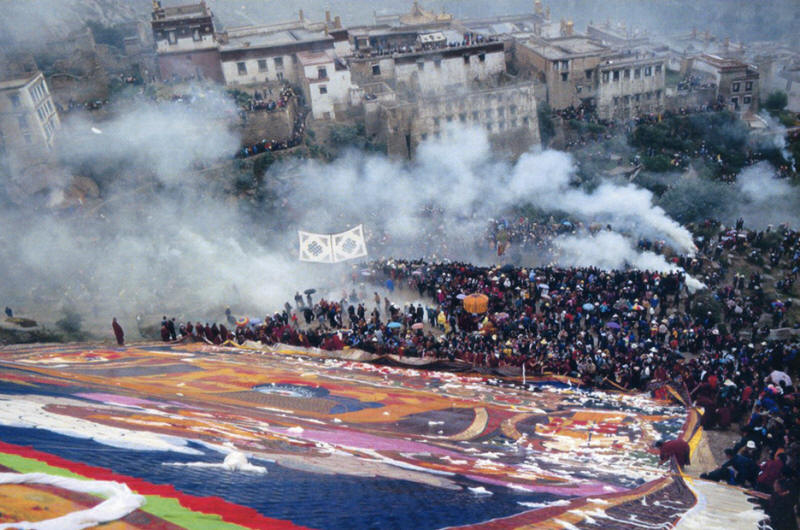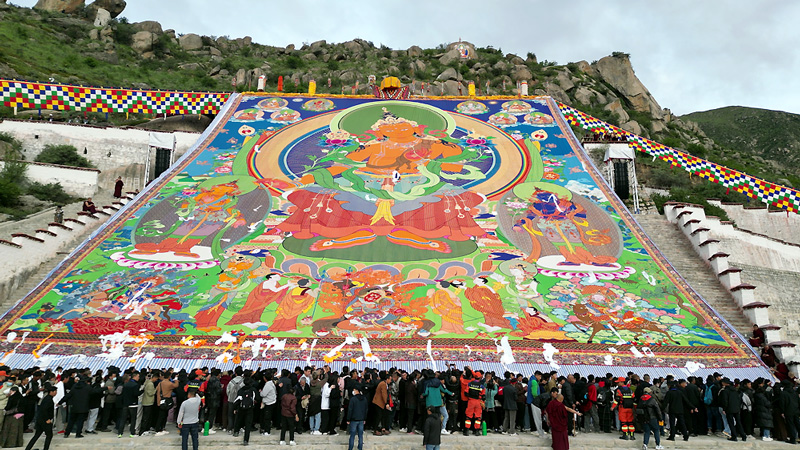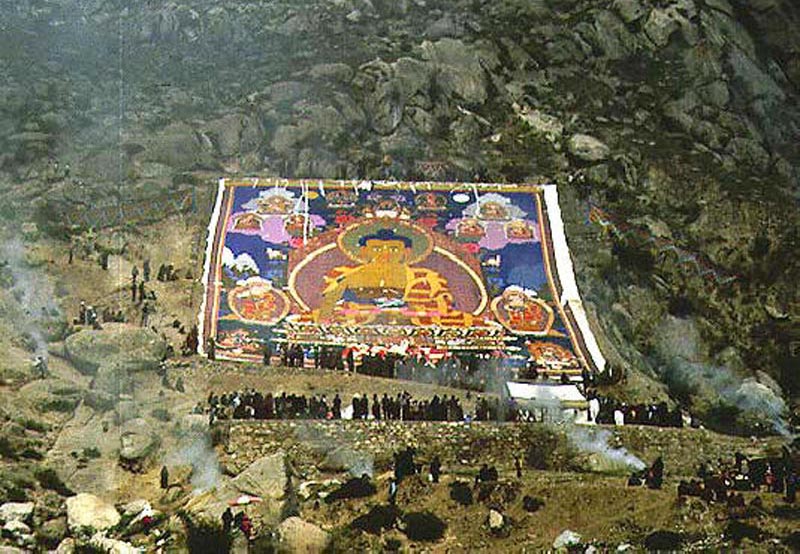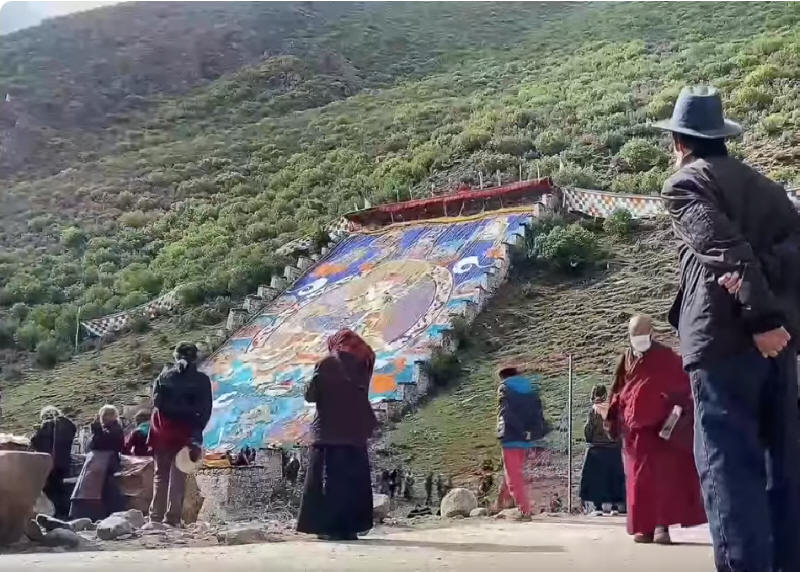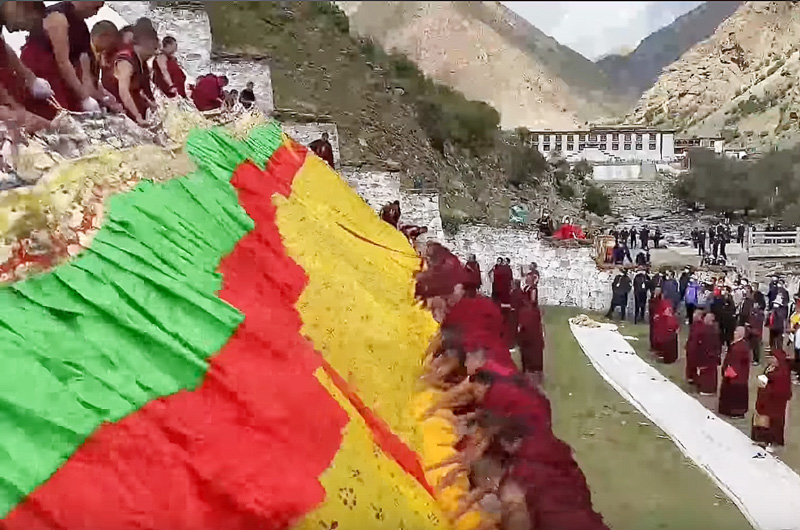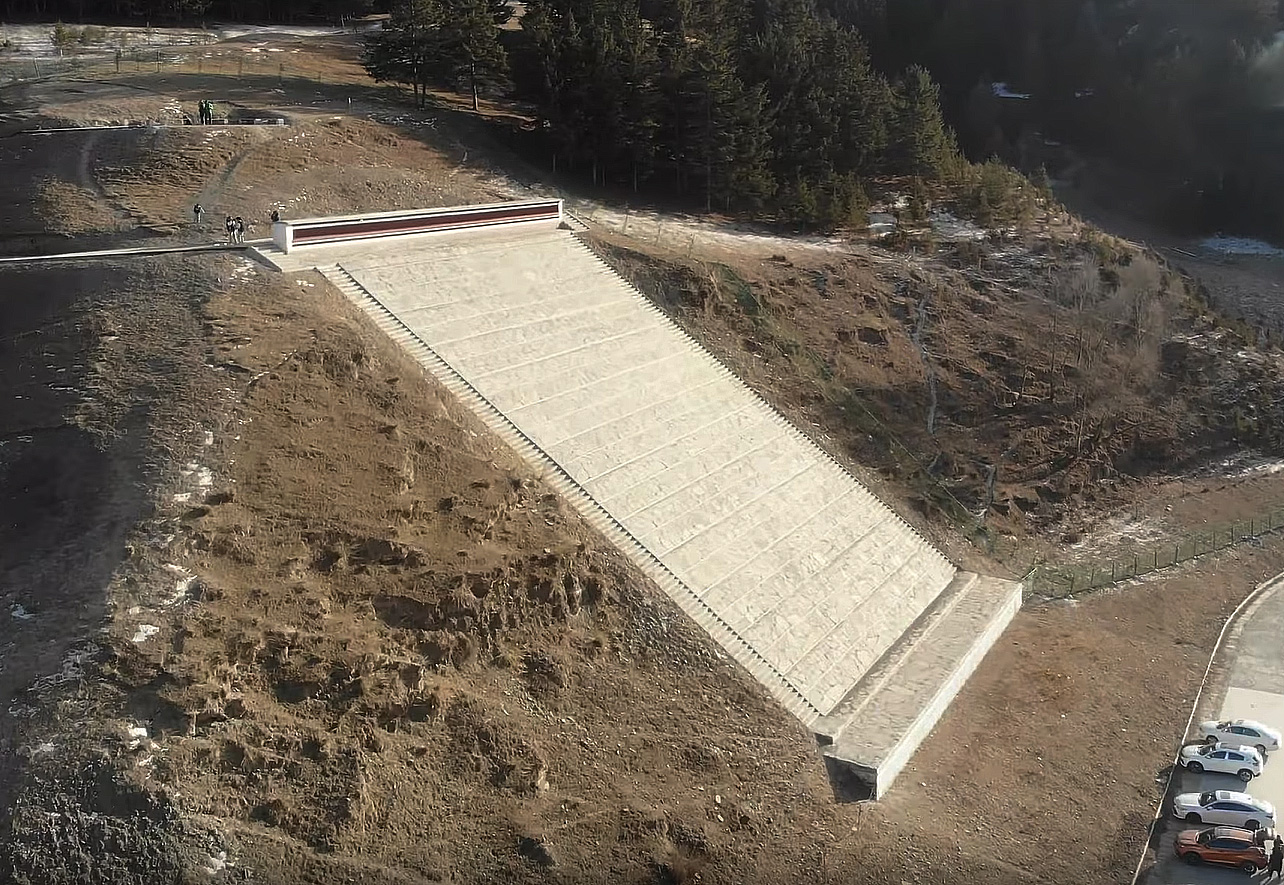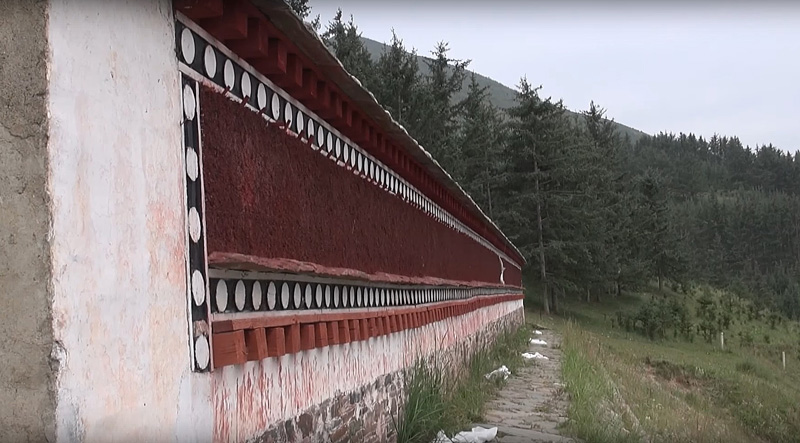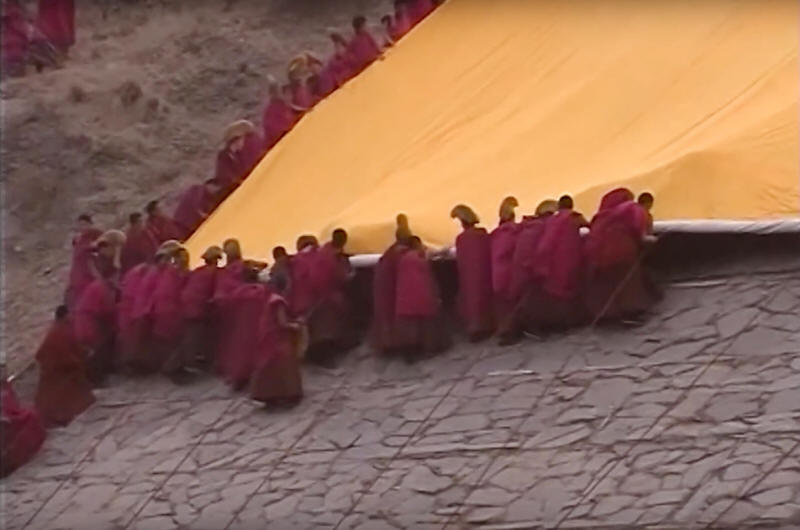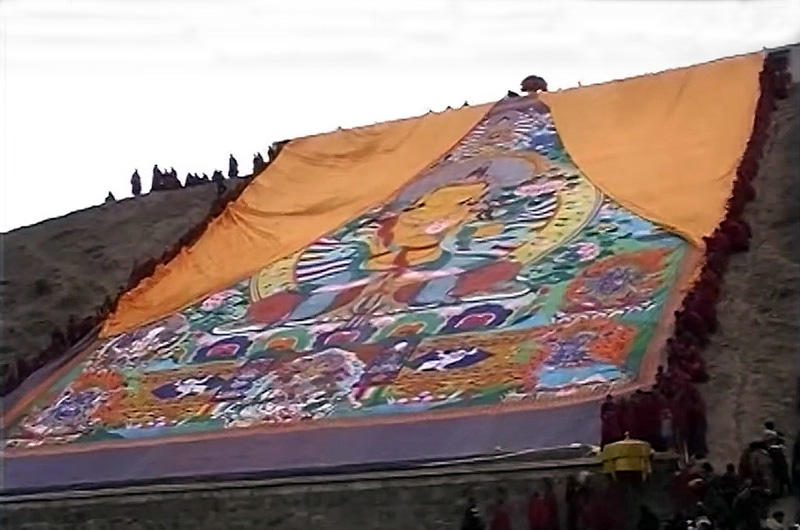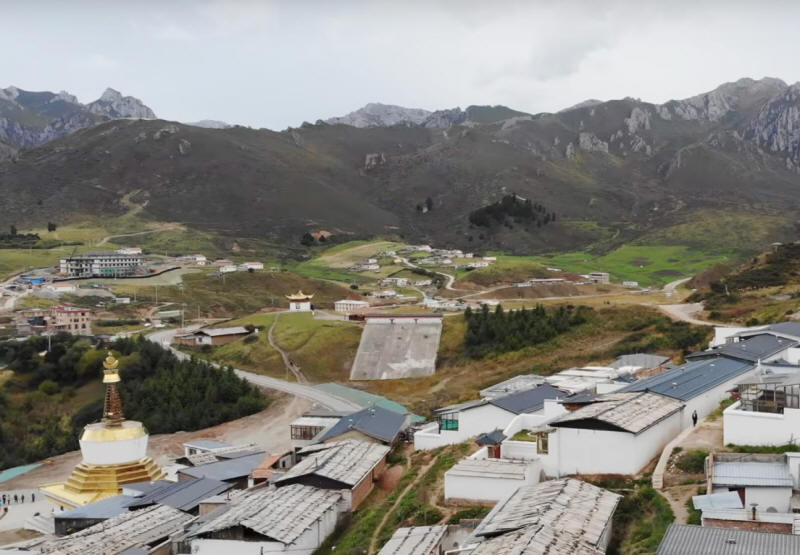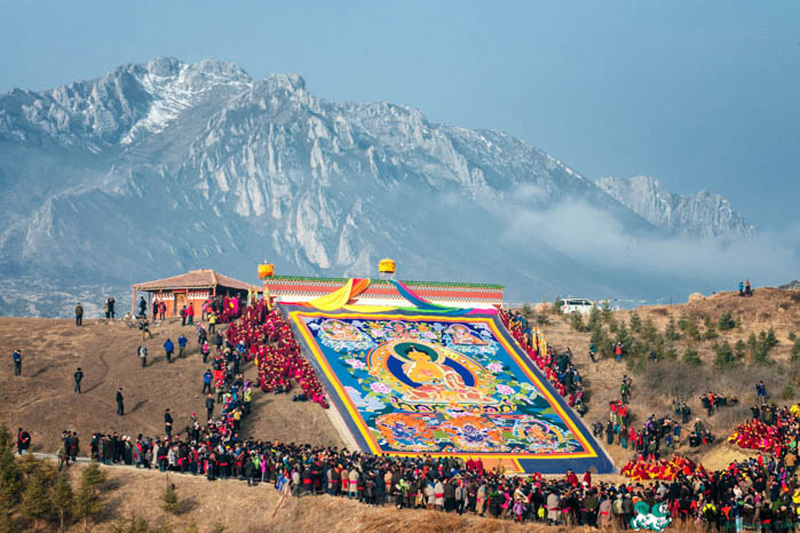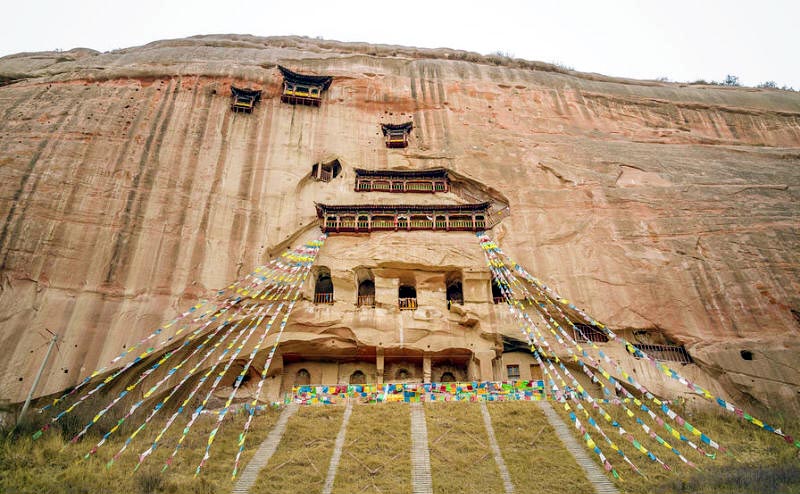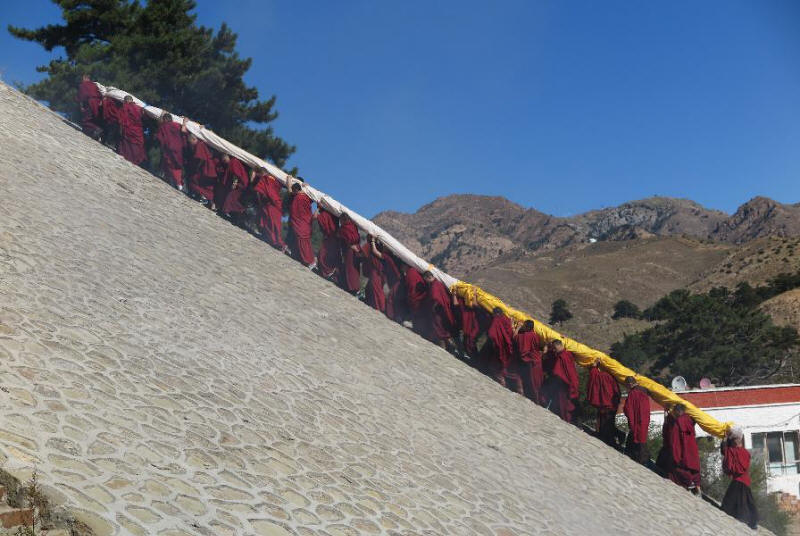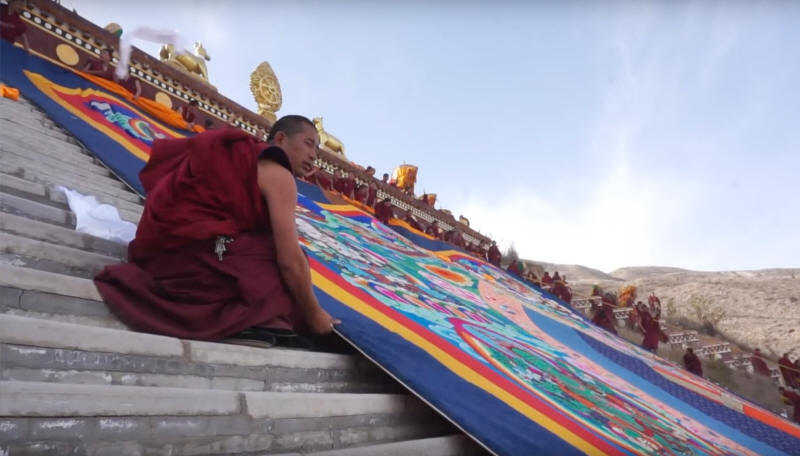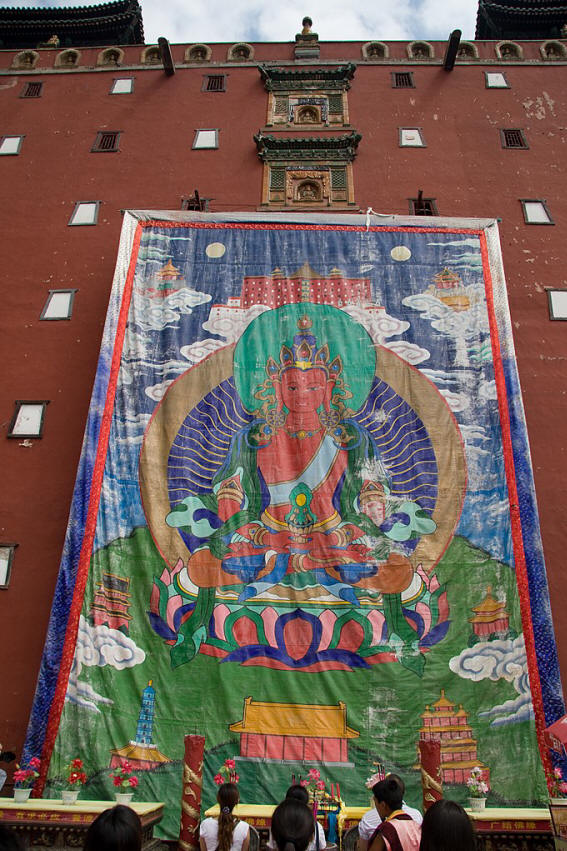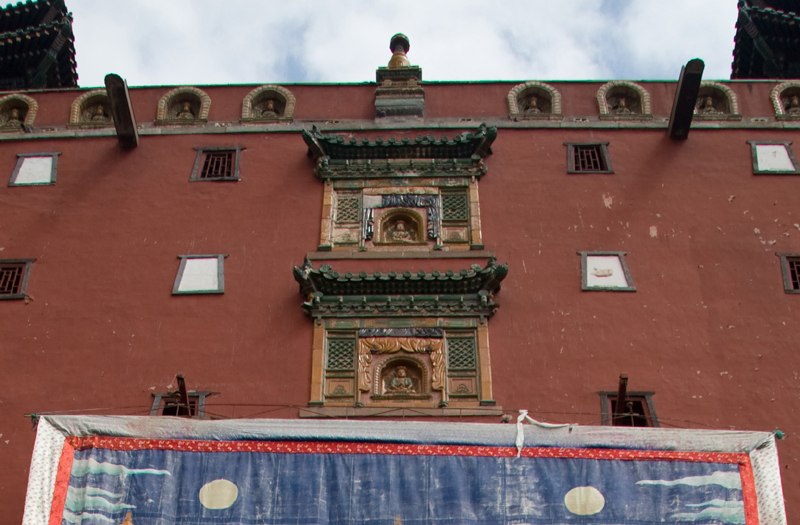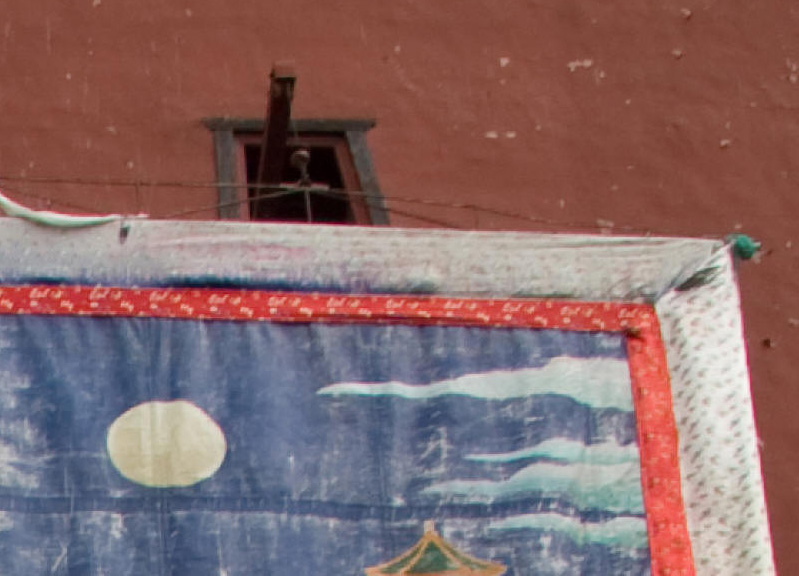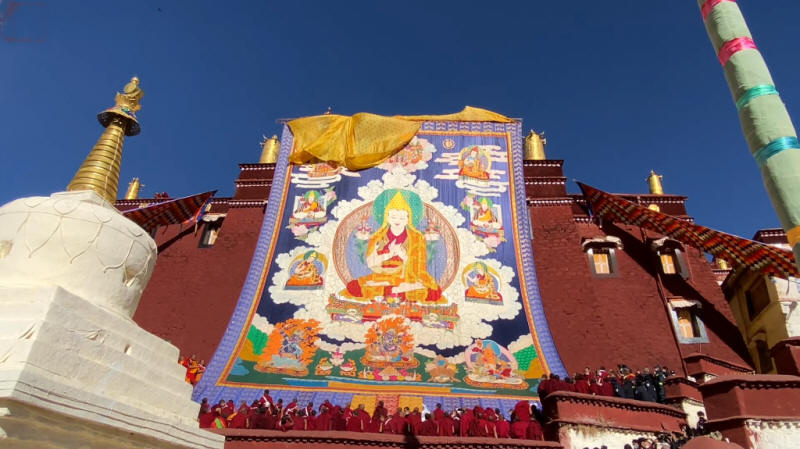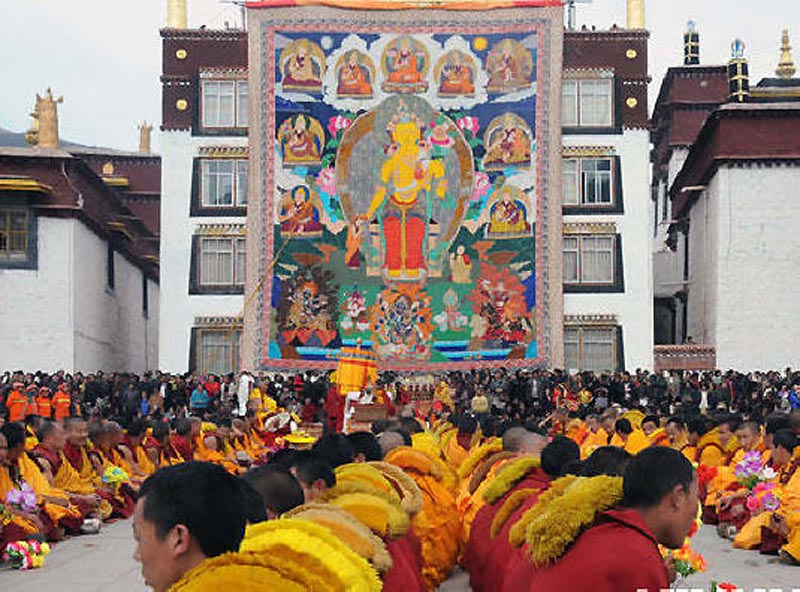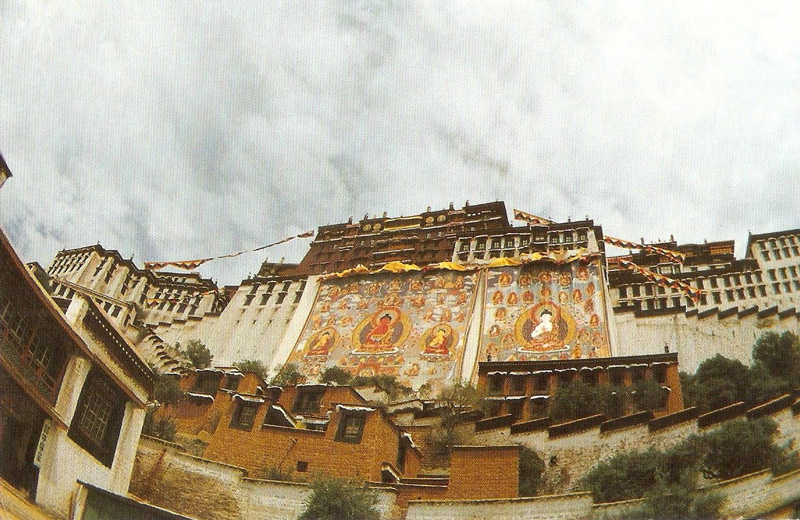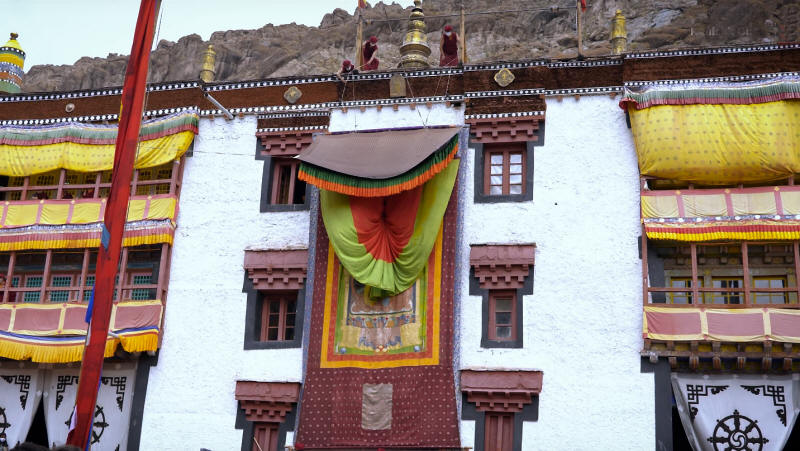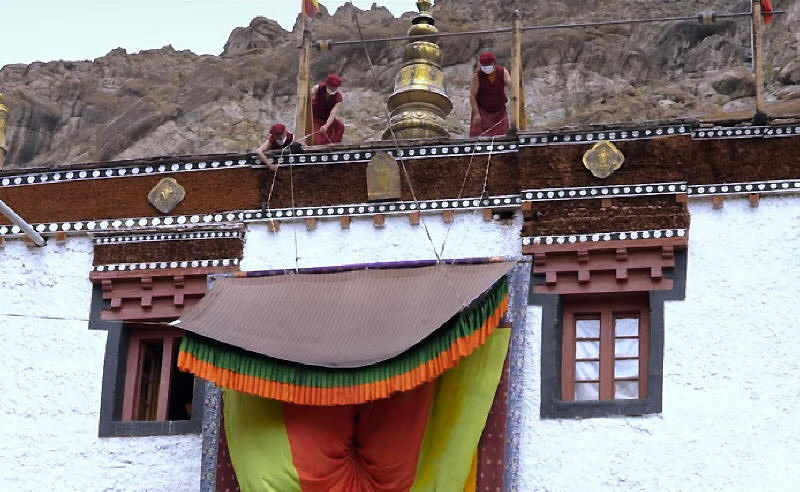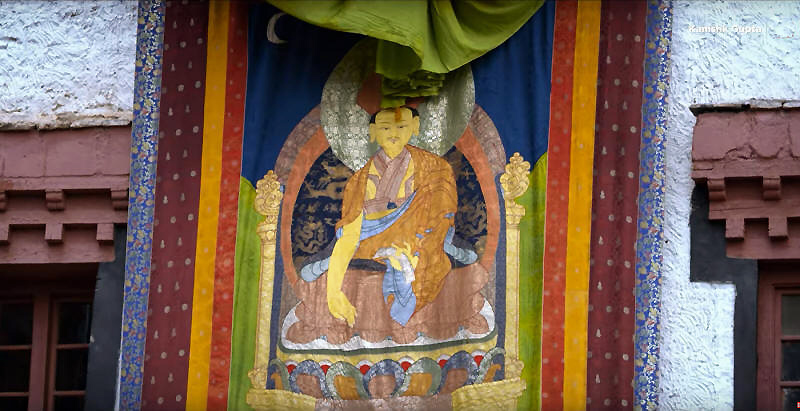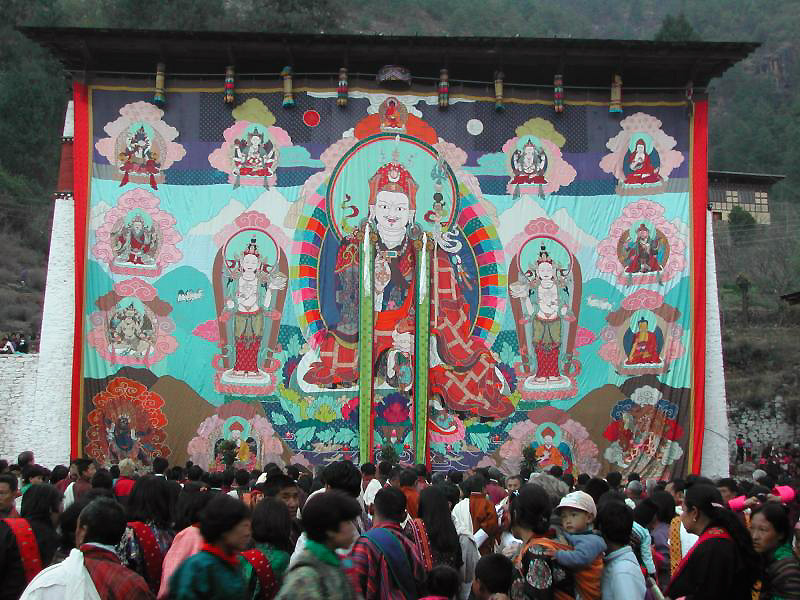Christian Lassure
This article follows the publication on this site, in 2018, of our study entitled “An architectural curiosity: the thangka walls of the great Tibetan monasteries”. It listed the buildings specially constructed for the ritual display of monumental thangkas (or tangkas) (also called geku or kiku in Tibetan), during festivals linked to the schools of Tibetan Buddhism. In the absence of a screen building dedicated to this task, the display of a large thangka (or giant thangka) was achieved by means of two substitutes: While the characteristics and operation of these devices are rarely described in detail, the examination of photos and videos posted online by Tourism allows us to get a less approximate idea of them.
1 - Inclined plane The inclined plane solution is attested for the monasteries of Drepung, Ganden, Tsurphu, Labrang, Taktsang Lhamo, Mati Si, Wudang and Rongwo, but it is possible that other cases exist that have not attracted attention until now.
1.1 - Drepung monastery The Drepung monastery, in the prefecture-level city of Lhasa, sees the unfurling, on the slope of a nearby hill, of a giant thangka 30 meters on each side, on the 30th day of the 6th lunar month (1), to mark the beginning of the Shoton festival (the "yogurt festival") (2). Carried from the storeroom where it is kept, to a tilted metal frame, where it is unrolled and unveiled by the monks at sunrise, the thangka represents Sakyamuni (or Shakyamuni), the founder of Buddhism, surrounded by various deities.
In 2016, on the occasion of the 600th anniversary of the founding of Drepung, the five-century-old Sakyamuni thangka was replaced, to ensure its preservation, by a new thangka representing the image of Maitreya,
the Buddha of the future (3).
(1) Victor Chan, Tibet. Le guide du pèlerin, Éditions Olizane, 1998, p. 1179-1180 ("Tibetan Festivals"). (2) Festival Begins in Tibet, Beijing Review, 5 septembre 2011. (3) Giant thangka on display at Tibetan monastery, govt.chinadaily.com.cn, updated Aug 17, 2023.
1.2 - Ganden monastery In the 1990s, the Ganden monastery used a hillside to display the large Sakyamuni thangka. A photo taken by Gérard Labre in August 1990 gives us a glimpse of this spectacular ceremony (4). Today, however, the event is held within the grounds of the reconstructed monastery itself, on the façade of a large red building (see Part 2, Façade of a central building, infra).
(4) Terris Temple and Leslie Nguyen, The Giant Thangkas of Tsurphu Monastery, Asianart.com, December 5, 1995.
1.3 - Tsurphu monastery The Kagyu (or Kagyu) monastery of Tsurphu, seat of the 17th Karmapa, in the prefecture-level city of Lhasa, displays, every tenth day of the fourth lunar month of the Tibetan year, a thangka of Sakyamuni, 35 meters long and 23 meters wide, on a sloping platform built on the side of a hill facing the monastery. This thangka, completed in 1994, replaces the one made in the 17th century, which disappeared after 1960. The top of the display area is bordered by a canopy under which monks stand, while the bottom is bordered by a terrace supported by a wall to accommodate the public and the rest of the monks. Two stepped walls border the area laterally (5). At the upper edge of the thangka, the yellow protective veil can be seen raised and rolled up.
(5) Terris Temple and Leslie Nguyen, op. cit.
1.4 - Labrang monastery At Labrang monastery, in Xiahe, Xiahe County, Gannan Tibetan Autonomous Prefecture (Gansu Province), the thangkas are displayed during the Monlam festival ("wish festival") on a paved area on the mountainside, flanked by stairs on each side and bordered by an independent wall at the top and a supported terrace at the bottom. The French poet Jean Dif, staying at Labrang in 2007, relates in detail the unrolling and unveiling of the Amitāyus thangka: "The rolled tanka is brought parallel to the upper edge of the wall [understand the platform, editor's note]. Monks line up on the two sloping sides; other monks take their places below the upper edge and begin to slowly unroll the fabric while moving backwards on the slope. Three bands of color gradually stretch out: a wider orange in the middle, two narrower red ones on each side. The monks work hard to ensure that the unfurling is carried out correctly, without making any folds. Having reached the lower edge of the platform, the monks, who have just unrolled the tanka, withdraw; the yellow band in the middle splits at the bottom, like a curtain opening, to gradually reveal, and let it be guessed, the image of Amitabha, bodhisattva of infinite light, of whom the Panchen Lama is the reincarnation. » (6).
(6) Jean Dif, Carnet de route d'un voyage en Amdo, février-mars 2007 - (Suite 2), http://jean.dif.free.
1.5 - Taktsang Lhamo monastery A masonry ramp, flanked by two side stairs and bordered by a stone wall at the top, is visible at the Taktsang Lhamo monastery (or Langmusi in Chinese), Luqu County, Gannan Tibetan Autonomous Prefecture, Gansu Province. During the Mönlam festival, this inclined plane is used to display a giant thangka representing the Buddha to the faithful.
1.6 - Mati Si temple A vast grassy embankment below the Mati Si Temple (the "horse hoof" temple), in the Yugur Autonomous County of Sunan, Zhangye prefecture-level city, Gansu province, is used to display a giant thangka. Five parallel stone staircases mark the footprint of the display area (7).
(7) Mati Temple Grottoes in the Cliff – China, tsemrinpoche.com, 14 mai 2019.
1.7 - Wudang monastery In the Wudang monastery in Baotou, Inner Mongolia (China), a thangka measuring 20 meters wide and 16.8 meters high is displayed at the beginning of the 8th lunar month, on a paved inclined plane following the slope of the mountain (8).
(8) « Gigantic Thangka Displayed at Wudangzhao Monastery », chinadaily.com, 14 septembre 2015.
1.8 - Rongwo monastery At Rongwo monastery in Longwu, Huangnam Tibetan Autonomous Prefecture, Qinghai, a large inclined plane is set up on a hillside. It hosts a large thangka during the Losar (Tibetan New Year) festival. Posted under the wall bordering the top of the inclined plane and on the sides, the monks have pulled up the orange veil that hid the image of the Buddha.
2 - Façade of a central buildingA third means used to display a monumental thangka for the devotion of the faithful is the façade of a large central building overlooking an esplanade. This is the case at Putuo Zongcheng, Ganden, Galden Jampaling, Lhasa (at the Potala) and at Hemis. 2.1 - Putuo Zongcheng Temple At the temple of Putuo Zongcheng, in Chengde, in the province of Hebei (China), the giant thangkas are displayed on the façade of the main building.
2.2 - Ganden monastery In the reconstructed Ganden monastery, a tapestry of Tsongkhapa, the founder of the Gelugpa school, is suspended from the top of the façade of a red building standing in the centre of the natural cirque. This arrangement replaces the old inclined plane on a hillside (9). The casing of the thangka and its protective veil is placed by the monks along the terrace bordering the façade. Two ropes lowered from the top hoist and unroll the tapestry. The yellow veil is then removed from above, revealing the large monastic figure.
(9) Ganden Monastery, chinaguide.com.
2.3 - Galden Jampaling monastery At Galden Jampaling monastery in Chamdo (Tibet Autonomous Region), a large four-story stone building is used to display a monumental thangka depicting Jampa. The thangka is taken out of storage and displayed every thirtieth day of the fifth lunar month (10).
(10) Victor Chan (op. cit., p. 511) mentions this device but the height indicated (18 m) could suggest another building. "This large building in stone slabs stands to the south-east of the Kumbum. Used to display an enormous fabric thangka (16 m by 8), it is the best preserved and tallest building (18 m) in the complex. Internal stone staircases connect its four levels".
2.4 - Potala Palace At the Potala Palace in Lhasa, the vast white lower façade facing south served as a support for two large thangkas displayed at the same time (11). They were suspended from the edge of the roof of the left part of the building, at the end of the Tibetan New Year celebrations (12). One of them, truly gigantic, that of Amitābha (the Buddha of Buddhas), is 55.8 meters high and 40 meters wide. The other thangka, less wide, represented the goddess Tara.
(11) Heinrich Harrer designates as the support of the thangkas "the lower white frontage of the Potala" (Return to Tibet: Tibet After the Chinese Occupation, J. P. Tarcher / Putnam, 1998, p. 183). (12) Brian Barry, Potpourri, Korean Heritage website, summer 2008: «The giant tangka of Amitābha in Potala Palace is reportedly 55.8 meters high and 40 meters wide ».
2.5 - Hemis monastery Another example of using a monastic building façade to display a large thangka is the Hemis monastery in Ladakh (India), which belongs to the Drukpa school. Every 12 years, on the first day of the annual festival celebrating the birth of Padmasambhava, the founder of Tibetan Buddhism, a thangka in his image is displayed on the façade of a two-story building (on the ground floor) bordering the monastery courtyard. This festival is held on the 10th day of the 5th month of the Tibetan calendar (i.e. at the junction of June and July). The last display was in 2016.
2.6 - Paro dzong The use of building facades is also attested in the monasteries of Bhutan, notably in the dzong (fortress) of Paro, in the district of the same name. Locally called thongdrol, or thongdrel (literally "liberation by sight"), the thangka is brought, in the form of a roll, to the bottom of the building, then unrolled and hoisted up to the level of the roof edge after having been attached (using rings?) to a long steel rod. During lifting, the rod must remain perfectly horizontal. Once in place, the fabric must be smoothed well to avoid creases. The thangka, which is 15 m on each side, is dedicated to Padmasambhava, alias Guru Rinpoche. It is taken out of its storeroom every year, in the spring, on the last day of the religious festival (tsechu) of Paro (i.e. the 15th day of the second Bhutanese lunar month). At least, this was the case in the 1990s (13).
(13) Jan Fontein, Notes on the Tshechu Festival in Paro and Thimphu, Bhutan, chapter VIII of India and Beyond: Aspects of Literature, Meaning, Ritual and Thought (Dick van der Meij ed.), Routledge, 2013, 711 pages (first published in 1997), p. 155-157.
With this brief evocation of the Bhutanese thongdrols, we will close this second part of our inventory of monumental thangka supports, hoping that further research will be undertaken following our work, in particular on
© Christian Lassure
To be referenced as: Christian Lassure Inclined planes and building façades for displaying thangkas in the monasteries of Tibetan buddhism July 10th, 2024
|
